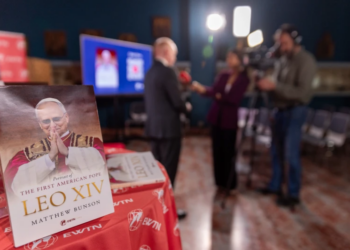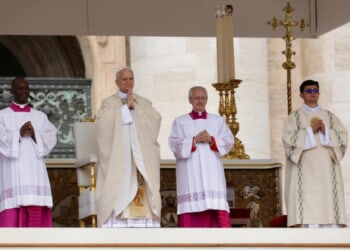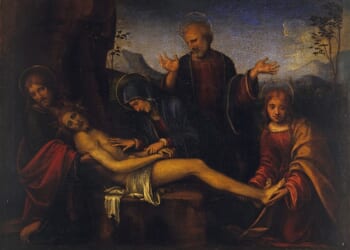Though Butch O’Hare did live to receive his Medal of Honor, he didn’t live to see the end of the war.
If you’ve ever lived in or traveled to the city of Chicago, Illinois, then you’re undoubtedly familiar with Chicago O’Hare International Airport.
But unless you’re a serious military aviation history buff, you may not be so familiar with that airport’s namesake. The airport had initially been known as Orchard Field Airport. But on September 19, 1949, it was renamed as a posthumous honor to Lieutenant Commander Edward “Butch” O’Hare, who was the U.S. Navy’s first air ace of World War II as well as the first naval aviator to receive the Medal of Honor. The National Interest now looks at Butch O’Hare’s all-too-brief but still remarkable military career.
Butch O’Hare Early Life and Initial Military Career
Edward Henry “Butch” O’Hare was born on March 13, 1914, in St. Louis, Missouri, the son of Edward Joseph “Easy Eddie” O’Hare and Selma Anna (née Lauth). His parents divorced in 1927, whereupon “Easy Eddie” moved to Chicago while Buch remained in St. Louis with his mother and his two sisters (Patricia and Marilyn).
“Easy Eddie” was a successful lawyer and dog track operator. Alas, he also got mixed in with the organized crime crowd, getting involved with Al Capone before later turning government witness. He paid the price for it: he was murdered by unidentified gunmen in 1939.
Luckily, young Butch didn’t end up following up in his dad’s footsteps. Instead, the father exerted a lasting positive influence on his son: Eddie had dabbled in flying airplanes on the side, and he familiarized the teenage Butch with the finer points of flying.
Thus, it came to pass that Butch graduated from the Western Military Academy in 1932, which gave the young man a good foundation for his accession to the United States Naval Academy the following year. Graduating with the USNA Class of 1937 and earning a commission as an ensign (pay grade O-1; equivalent of a 2nd lieutenant in the Army, Air Force, and Marine Corps). He spent the first two years of his career as a surface warfare officer on the battleship USS New Mexico (BB-40) before reporting to NAS Pensacola for flight training, whereupon he earned his naval aviator’s wings on May 2, 1940.
From there, ENS O’Hare was ordered to Fighter Squadron Three (VF-3) aboard USS Saratoga (CV-3), which was based in San Diego, California. His unit got bounced around from the Saratoga to USS Enterprise (CV-6), back to the Saratoga, and finally was reassigned to the USS Lexington (CV-2) after the United States entered World War II and the Saratoga was damaged by a Japanese torpedo. The warbird platform that Butch was thusly assigned to was the Grumman F4F Wildcat fighter plane.
During this time, Butch made a name for himself as a gifted aviator and marksman and earned the recognition and praise of his commander, then-Lieutenant (later admiral) John Thach of “Thach Weave” fame.
Wartime Exploits and Earning the MOH
The Lexington and F4F Wildcat tandem would prove to be the launching platform—both literally and figuratively—for Butch O’Hare’s most famous wartime exploit, which transpired on February 20, 1942. On that day, “Lady Lex” was beset upon by two formations of Mitsubishi G4M “Betty” twin-engine torpedo bombers. O’Hare, by this time a lieutenant, was assigned to the second wave.
O’Hare’s official MOH citation picks up the story from there:
“Having lost the assistance of his teammates, Lt. O’Hare interposed his plane between his ship and an advancing enemy formation of nine attacking twin-engined heavy bombers. Without hesitation, alone and unaided, he repeatedly attacked this enemy formation, at close range in the face of intense combined machine-gun and cannon fire. Despite his concentrated opposition, Lt. O’Hare, by his gallant and courageous action, his extremely skillful marksmanship in making the most of every shot of his limited amount of ammunition, shot down five enemy bombers and severely damaged a sixth before they reached the bomb release point. As a result of his gallant action one of the most daring, if not the most daring, single action in the history of combat aviation he undoubtedly saved his carrier from serious damage.”
In other words, not only was Butch the first USN air ace of WWII, he was an ace-in-a-day!
Death and Tributes to Butch O’Hare
Tragically, though Butch O’Hare did live to receive his MOH, he didn’t live to see the end of the war. As noted in a June 2018 article War History Online by Sarah Woodline:
“Butch received these three awards after his Medal of Honor: the Distinguished Flying Crosses in August and October 1943, and the Navy Cross posthumously, because in the face of an imminent Japanese attack on Lexington’s task group near Tarawa, Butch ‘personally organized and voluntarily led the first night fighter section of aircraft to operate from a carrier, at night, against enemy aircraft, although he well knew the hazard involved’ … Hazardous indeed, for Butch never returned from that night mission in November 1943.”
Ironically, Butch was felled by the guns of the same aircraft type that he had ravaged back in February 1942: the Betty bomber.
In addition to his mother, O’Hare was survived by his wife Rita and nine-month-old daughter Kathleen. Besides the airport renaming, LCDR O’Hare was also posthumously honored as follows:
About the Author: Christian D. Orr
Christian D. Orr was previously a Senior Defense Editor for National Security Journal (NSJ) and 19FortyFive. He is a former Air Force Security Forces officer, Federal law enforcement officer, and private military contractor (with assignments worked in Iraq, the United Arab Emirates, Kosovo, Japan, Germany, and the Pentagon). Chris holds a B.A. in International Relations from the University of Southern California (USC) and an M.A. in Intelligence Studies (concentration in Terrorism Studies) from American Military University (AMU). He has also been published in The Daily Torch, The Journal of Intelligence and Cyber Security, and Simple Flying. Last but not least, he is a Companion of the Order of the Naval Order of the United States (NOUS). If you’d like to pick his brain further, you can ofttimes find him at the Old Virginia Tobacco Company (OVTC) lounge in Manassas, Virginia, partaking of fine stogies and good quality human camaraderie.
Image: Shutterstock

















